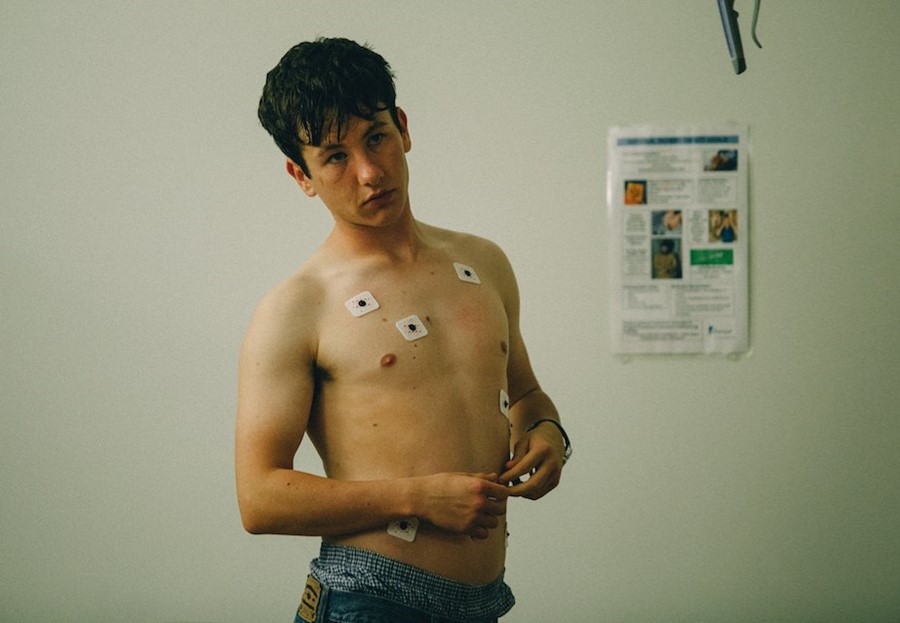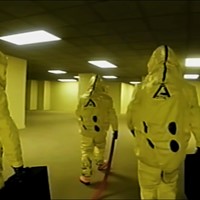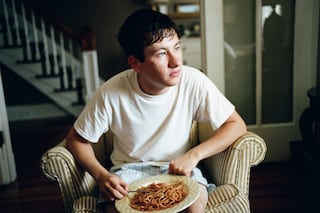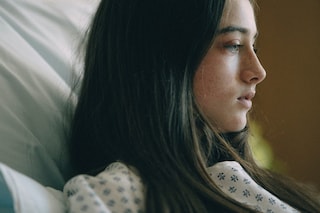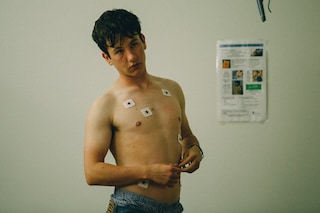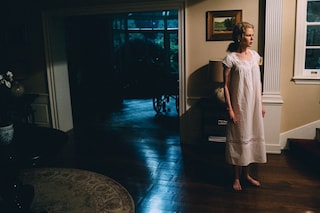The Killing of a Sacred Deer’s breakout Irish star (and part-time boxer) on the healing power of movie-making
Taken from our winter issue, which comes out on November 23
How did you learn to play such a convincing psychopath? This is the question I’m dying to ask Barry Keoghan, Irish actor and star of director Yorgos Lanthimos’s The Killing of a Sacred Deer. In the film, he gives a tightly coiled performance as Martin, an increasingly unhinged 16 year-old who develops an unhealthy obsession with Colin Farrell’s solemn heart surgeon Steven – for reasons that are not immediately revealed. When Steven’s daughter Kim mysteriously loses the use of her legs, Martin responds with cold malevolence: “I don’t know if what’s happening is fair, but it’s the only thing I can think of that’s close to justice.” But my own conversation with Keoghan is not what you’d call a killer first impression. Speaking to him at his home in Ireland, he seems so... normal.
The 25-year-old grew up in ‘Dublin 1’, the innermost district of the Irish capital, and spent five years of his childhood in foster care with his brother while his mother suffered and eventually succumbed to the heroin epidemic that swept Dublin in the 1990s. “My nanny took me in at 12 with my brother, who is a year younger than me,” he says. “We’re the closest brothers you’ll ever meet.”
A tough upbringing meant that Keoghan had to learn to be “streetwise”. He describes himself as “a messer, in school, and on the streets hanging around with friends”. “I wasn’t stupid, or very smart,” he says. “I didn’t finish my education.”
“Where I’m from, you focus on finishing school. Even finishing college is seen as a stretch – you just get a job after school and that’s it. Acting isn’t a big thing around there. (My brother) didn’t think I would ever be doing something like this – no one did.” How, then, does a messer like Keoghan end up working with some of the most critically acclaimed directors in Hollywood?
“I saw a note in a window for a street casting,” says Keoghan.“I’d acted in school – just Christmas plays, a bit of messing around on stage – and so I called the (number on the) street-casting thing.” The ‘street casting thing’ was for a gangster film called Between the Canals. Writer-director Mark O’Connor gave Keoghan a part after meeting, and from there, as he says, “it just took off”.
Since that first acting gig, Keoghan has appeared in roles ranging from maniacal cat killer in the fourth series of gritty Irish TV drama Love/Hate to earnest, wannabe war hero in Christopher Nolan’s sweeping second world war epic Dunkirk. He didn’t go to drama school; instead, his acting training came by way of a formative drama workshop at a performance space called The Factory (now rebranded as Bow Street academy). “This was about ten men getting together every week, for 14 hours a day,” says Keoghan. “Sometimes I would skip school to go (there) and watch old movies and documentaries. We would watch human behaviour – this is how I learned my craft.”
It was a technique that Keoghan brought to the part of Sacred Deer’s Martin. He built the character by “watching documentaries of kids, putting jigsaws together and being so occupied with something that they didn’t react to a camera”. Noting this lack of self-awareness, Keoghan realised that “the more innocent and downplayed Martin was, the more impact the creepiness had”.
The film is equal parts psychological thriller, nightmarish arthouse horror and black comedy; it’s the pulsing dread of Polanski’s Rosemary’s Baby meets Haneke’s gallows humour and Kubrickian clinical formalism. Not that Keoghan is a diehard fan of horror films – yet. “I’m gonna see mother! tonight, by Darren Aronofsky, and I just watched It. A while back I watched The Witch by Robert Eggers, which I absolutely loved. They’re something I’m getting into, horror movies – but I didn’t feel like The Killing of a Sacred Deer was a horror when I was making it.”
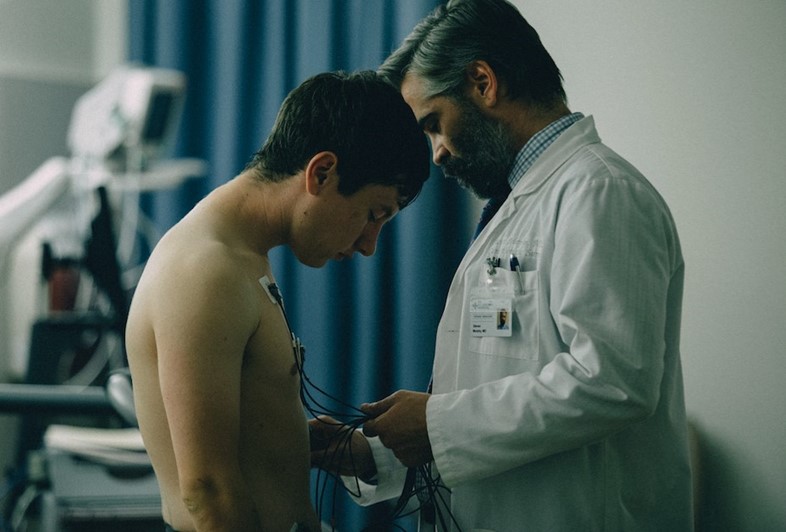
Even if the film isn’t strictly a horror, Keoghan’s Martin is certainly creepy, smoking a cigarette as the 14-year-old Kim (Raffey Cassidy) strips down to her underwear, or nonchalantly shovelling cold spaghetti into his mouth while Nicole Kidman’s Anna begs him not to hurt her kids. There’s something about Keoghan’s face, too – young-looking for his age, but with a piercing, unreadable stare – that makes Martin all the more chilling. Of his character’s sociopathic indifference, Keoghan explains how “the dialogue takes care of a lot of that”. There’s blunt comedy in the dark things Lanthimos’s characters say, especially when delivered with the mannered, flat affect that’s come to typify how they say them. Keoghan’s preferred form of comedy, however, is “hidden-camera stuff – just real stuff ”. “I like Jackass because they’re practical jokers. I find pranks funny, people in uncomfortable situations.” In the past, he’s pulled a few of his own pranks, too. “I’ve made a few phone calls, put on different accents. I pretended to be someone from a TV subscription service saying the person owes €500. I just found their reactions funny.”
With its classical structure and devastating, Sophie’s Choice-style final flourish, Sacred Deer plays out like a tragedy of Greek proportions. Keoghan’s usual process is classical, too, and involves a dedicated notebook for each role, filled with questions his grandmother writes for him to answer in character. “I didn’t have one for this movie, though,” he says. “It was very, very refreshing to go into a movie and not have this whole backstory. Yorgos was like, ‘Know your lines and don’t attach emotion to them.’” Lanthimos was on Keoghan’s hit-list of dream directors, written in his iPhone notes and confidently presented to his agents when he signed with WME and Management 360. “I (added Yorgos to) the list from watching The Lobster and Dogtooth – I looked up who’d done them.” Other names included “A24, Film4, Bart Layton, Yann Demange and Chris Nolan”, all of whom Keoghan has now worked with. “I had nothing behind me, but I had this list. I was like, ‘These are the people I want to work with.’ I’ve gotten really into (new-age philosophy) the law of attraction; I watched a documentary and read a bit (about it).”
“I wanted to prove (myself) and show that a kid who’s been through all of this, and I mean a lot, can still get to the top... That was my drive” - Barry Keoghan
Keoghan is friendly but reserved, soft-spoken, a little serious. He’s seemingly easygoing, but hard to get a sense of. It’s only when he tells me about The List that something clicks, and I start to understand how passionate – and doggedly ambitious – he is about his career. “After everything I’ve been through – the foster-care, the losing my parents and stuff like that, I was never one to kind of go, I’m gonna just not try,” he says. “I used it all as ammunition. I wanted to prove (myself) and show that a kid who’s been through all of this, and I mean a lot, can still get to the top. You can come from anywhere, (with no) family or opportunities – I just wanted to prove that it was possible. That was my drive.”
When asked what his next move might be, Keoghan assures me he is being “very patient”. “I’ve just worked with Chris Nolan, Yorgos Lanthimos, and Bart Layton on this movie called American Animals, which is out soon. I don’t mind waiting around. I don’t want to rush into work for the sake of working. I want to pick good movies, and good characters, from unique filmmakers.” It’s testament to his talent and work ethic that he’s been able to be this selective – and to pull it off – at this early stage in his career.
But Keoghan’s ambitions stretch beyond acting. “I’ve got this film camera that Yorgos gave me at the end of Sacred Deer. He noticed that I’d always be behind the camera looking at the frame; I was always inquisitive about these things, so he bought me this camera. Then Colin bought me a digital camera as well, so I came off this movie with two cameras. When you look through a (lens), it’s different to what you normally see. I’m always taking pictures of my girlfriend, and just catching people on camera. I’m very into seeing how people behave – that’s probably the director in me coming out.”
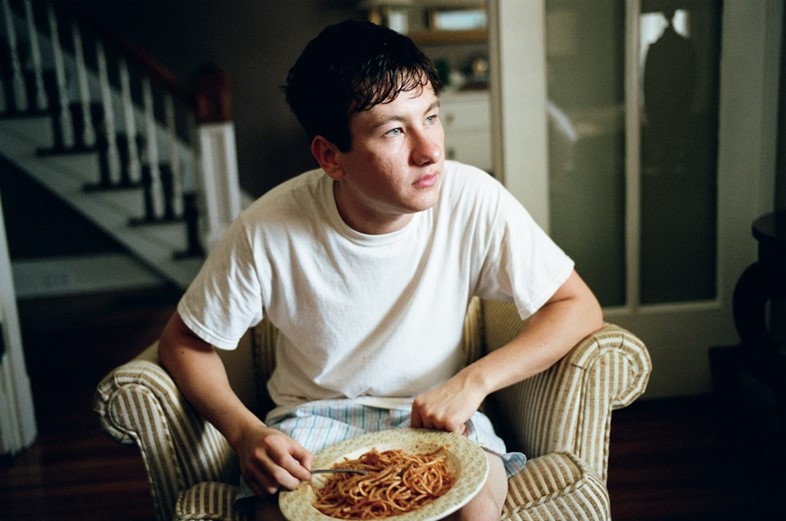
“I have a few projects that I’m developing,” he continues. “It’s something that I wanna do. I definitely wanna direct.” Which directors would he like to emulate? “Paul Thomas Anderson, Martin Scorsese, Jeff Nichols – there’s tonnes. They’re all on The List, by the way.”
I’m curious to know what Keoghan’s girlfriend Shona – a firm fixture on his Instagram, by his side at Paris Fashion Week and on set during this shoot – makes of all this. “We’ve been together for about seven months now. It’s very overwhelming to be dropped into this world, for anyone. But she is very proud, and she is very supportive as well.” She and Keoghan came up with the locations for the shoot, suggesting their favourite spots in Killarney, like Ladies View, and a disused house that was bombed out and used by the British army while fighting the IRA. When I ask how they met, he tells me, “I went on holiday seven months ago, and I haven’t been home yet. It was the best holiday I’ve ever been on. I offered to buy her a drink and she said no – that’s when I knew, This is the girl!”
Shona is the reason Keoghan chooses to stay in Ireland, rather than London or Los Angeles. “I come home and there’s no airs and graces about me,” he says. “I’m back to being Barry. That’s why I’m staying here in Ireland – I’m surrounded by good people and I want to keep my feet on the ground.” I prod him for wacky anecdotes about his first year of fame, but he’s surprisingly low-key (either that, or determined to keep our conversation Strictly Business). “Meeting Tom Hardy, that was the biggest thing, you know? I’m a big fan of his. Me and the girlfriend were at the Dunkirk premiere, and I was... not starstruck, but I was like, ‘Oh! It’s Tom Hardy!’ We started talking about boxing and MMA (mixed martial arts) – he’s a great dude, he really is.”
“I enjoy putting someone else’s shoes on. (Acting) is therapeutic. I couldn’t pinpoint what it is I was getting from it, that is the beauty” - Barry Keoghan
Though Keoghan is serious about success, he’s not competitive in the traditional sense, speaking about his colleagues with generosity. “I go up against my friends, sometimes we go for the same parts – it’s something we talk about. It’s gonna happen in this game – but if I didn’t get it, I’d want one of my friends to get it. We’re all very supportive of each other.” It seems that working with a group of young men similar in age to him on Dunkirk was a good way to create a healthy sense of solidarity with his fellow actors.
“We stay in touch; we’re all very close,” he says.
Do you have a WhatsApp group?
“We do have a WhatsApp group,” he confirms. “It’s called ‘Funkirk’.” Although, Keoghan is quick to add, “it wasn’t all fun and games. There are things to (think about on set) so you can’t really be making a joke when it comes to hitting your mark. You’ve got to be quite serious. (At the same time) you have to be chill, relaxed and know what you’re doing.”
Though he’s prolific on Instagram, Keoghan is somewhat sceptical about social media. The only difference between his current posts and the ones from before he was famous is the amount of people liking them. “More followers and that blue-tick thing. They said that it’s officially me. It’s madness, that blue tick. Like, oh yeah, now he’s real! Ridiculous.” Slightly embarrassed, I ask if he’s seen the Twitter account that compares him to puppies (@barryaspuppies, for the curious reader). “Oh Jesus, I have seen that. Barry as puppies, Barry as wolves, Barry as horses... I mean, I am a big fan of animals. I love all that.” In fact, he follows the account (its bio reads: the puppy follows). “They should verify that page!”
Memes aside, I venture that it can’t be easy adjusting to this new pace of life, with its circus of premieres and whirlwind scheduling. “There are no complaints to be made about this job,” he replies, not missing a beat. “Obviously the money is good, you get flown places, you get treated very well. But it’s a kid’s job – you’re pretending to be different people.”
“I enjoy putting someone else’s shoes on. I wasn’t one to go home and express my feelings. (Acting) is therapeutic. I couldn’t pinpoint what it is I was getting from it, that is the beauty; I actually don’t know what it is. The hardest thing about it is probably not working, because you always want to be working.”
When he isn’t working, Keoghan is boxing – showing up to the shoot in Killarney with swollen, cut knuckles and shadow-boxing between takes. His first fight, he says, will go ahead this November. “It’s a hard competition because Irish boxers are very, very good. Boxing is something I’ve done as a kid – and I’m a big fan. I’ve got a bit of time now, I’ve committed to training – it’s fun. I’m not taking it too seriously.” His favourite boxing movie is Raging Bull, because “it touches on (the boxer’s) emotions”.
“You don’t really see that in boxing movies these days,” he continues. “They focus more on the choreography and how they look – they’re always so muscly. I’m waiting for a good boxing script to come along where you’re with the boxer outside the ring, and you see how he holds himself up.”
The Killing of a Sacred Deer is in UK cinemas now
